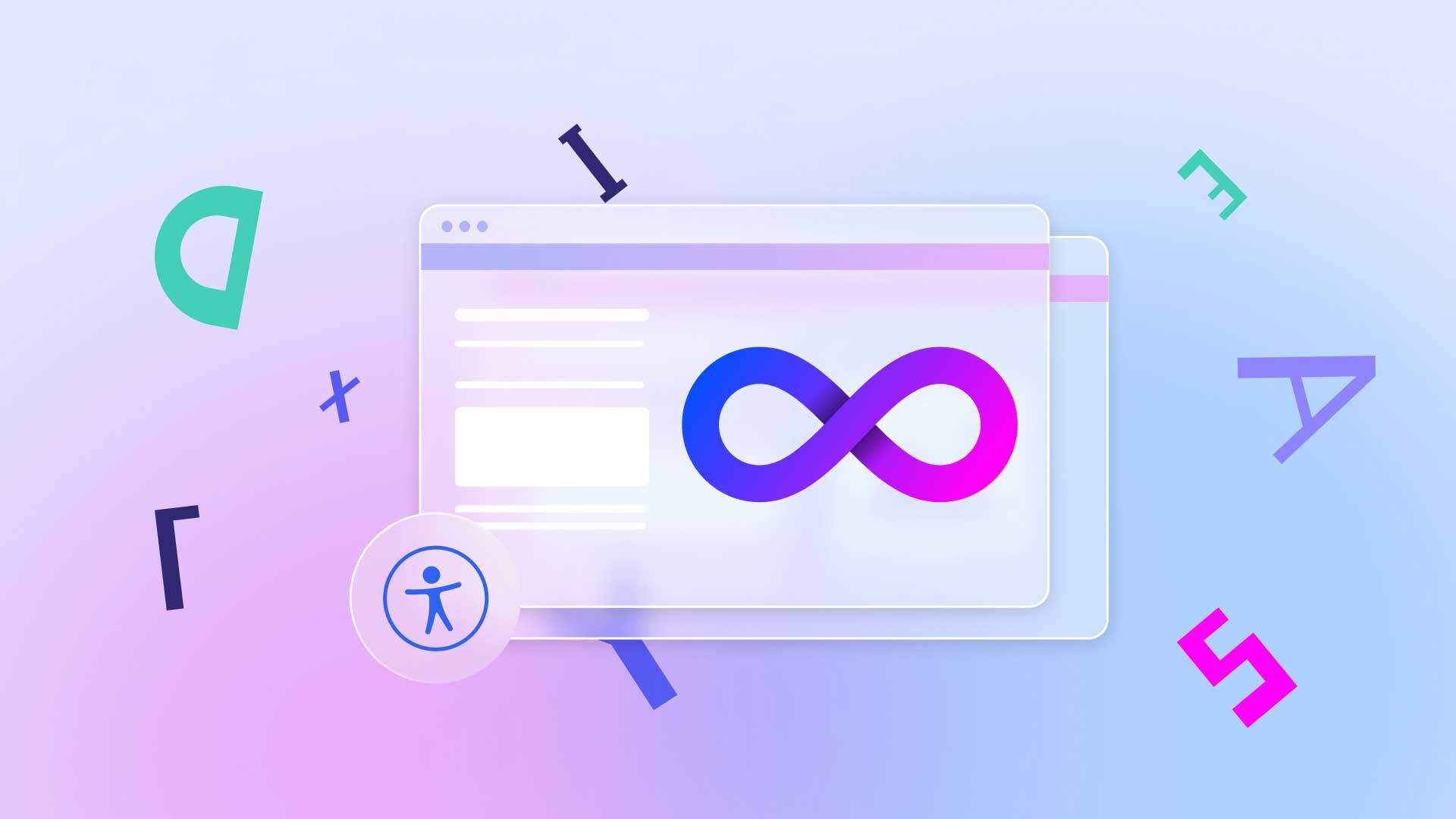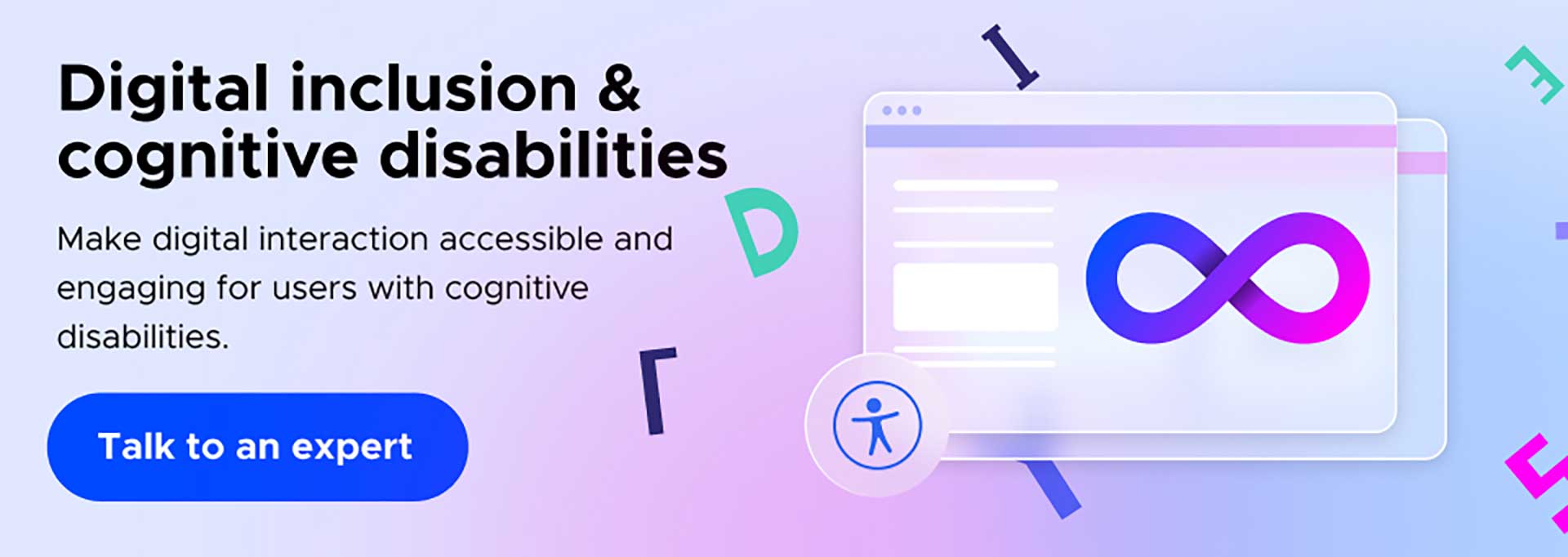Accessibility First: Web Design for Users with Cognitive Disabilities

Have you ever considered the digital barriers faced by individuals with cognitive disabilities? What happens when websites and apps are confusing, overwhelming or difficult to navigate?
Imagine for a moment that every website you visit is like a maze, where every link, button, or piece of information is full of barriers and obstacles.
For individuals with cognitive disabilities, this is an everyday reality. Websites and apps that are cluttered, unclear, or overly complex become digital labyrinths, shutting many people out of the online world.
This emphasizes the importance of giving priority to digital accessibility, ensuring that individuals with cognitive impairments can access the web effortlessly, free from barriers.
Let’s explore how we can transform digital spaces into user-friendly pathways for everyone, including people with cognitive challenges.
What are cognitive disabilities?
The meaning of cognitive disability refers to a condition that impacts cognitive functioning, intellectual abilities, and adaptive behavior. Cognitive disabilities cover a broad spectrum of conditions, each with its own unique characteristics and challenges.
Individuals may identify with having a cognitive learning disability, developmental cognitive disability or they may have intellectual disabilities. Understanding these categories is vital in providing accommodations that empower people to navigate the challenges they face while harnessing their unique strengths and potential. Recognizing these distinctions also supports website owners to create inclusive online environments tailored to individual needs.
What are common cognitive disabilities?
In this section, we’ll look at a few of the most common cognitive disabilities, illustrating the neurodiverse spectrum. Here are 5 types of cognitive disabilities::
1. Dyslexia: Dyslexia is a reading disability that affects a person’s ability to decode words and comprehend written text. Individuals with dyslexia may struggle with reading fluency, spelling, and writing.
2. Dysgraphia: Dysgraphia pertains to difficulties with handwriting and fine motor skills. Individuals with dysgraphia may have trouble forming letters and writing legibly.
3. Dyscalculia: Dyscalculia is a math learning disability that results in challenges with mathematical concepts, number recognition, and arithmetic calculations.
4. Autism Spectrum Disorders: ASDs affect social communication and behavior, leading to difficulties in social interaction, language development, and repetitive behaviors. They vary in severity and presentation.
5. Attention-Deficit/Hyperactivity Disorder (ADHD): ADHD is characterized by difficulties in sustaining attention, hyperactivity, and impulsivity. It affects focus, organization, and impulse control.
Additional examples of cognitive disabilities encompass conditions such as Down Syndrome, Traumatic Brain Injury, and Language Processing Disorder.
‘Brain Fog’ and cognitive impairment
Brain fog is also a type of cognitive impairment. It is a commonly used term to describe feelings of confusion, forgetfulness, and a lack of focus or mental clarity, Brain fog can affect anyone, regardless of age or background.
Various medical conditions and situations contribute to brain fog. For example, Long Covid survivors often report lingering cognitive disturbances long after other symptoms have subsided. Similarly, individuals with autoimmune diseases may experience periods where their thoughts seem clouded or inaccessible. Furthermore, cancer patients undergoing treatments like chemotherapy frequently face challenges with concentration and memory.
Certain medications also list brain fog as a potential side effect. Recognizing the myriad causes of brain fog is crucial as it not only fosters empathy for those experiencing it but also paves the way for targeted interventions, coping strategies and accommodations.
So how can we actively enhance inclusivity in our online spaces for individuals across the cognitive disability spectrum? Are there guidelines available to assist in weaving accessibility into websites?
Cognitive Accessibility: the path to online inclusion
Cognitive accessibility refers to the design and implementation of digital content and technology in a way that accommodates individuals with cognitive disabilities or challenges. It aims to make information and digital interfaces more understandable, navigable, and user-friendly for people who may have difficulties with comprehension, memory, attention, or problem-solving.
Fortunately, there are established guidelines that help website owners, designers and developers to achieve this goal.
The World Wide Web Consortium (W3C) sets the standard for web accessibility, including cognitive accessibility. W3C formulated the Web Content Accessibility Guidelines (WCAG), which encompass requirements specifically designed to enhance cognitive accessibility.
The specific version of WCAG is crucial for comprehensive accessibility. WCAG 2.1 fell short in fully addressing the needs of individuals with cognitive disabilities; it’s imperative to shift focus to WCAG 2.2 for a more inclusive approach.
How to brighten your website for ‘WCAG standard’ cognitive accessibility
To ensure barrier-free access to the web, your digital assets should adhere to WCAG guidelines. Let’s break down the WCAG success criteria into simplified terms:
- Consistent navigation: Make sure your website navigation is consistent across all pages. This helps users predict where to find information, reducing cognitive load.
- Readable text: Opt for simple, easy-to-read fonts. Large text and adequate spacing can make content more digestible for all users.
- Clear structure: Use headings, lists, and other formatting tools to break up text. This offers a roadmap for content, guiding users effortlessly through your site.
- Avoid unnecessary complexity: Keep your design and content straightforward. Complex designs can be distracting or even confusing for some users.
- Use familiar symbols & icons: Stick to widely recognized symbols and icons. This reduces the need for users to learn new visual languages.
- Multiple paths to content: For users who struggle with text, consider adding graphics, audio descriptions, or video explanations.
- Give enough time: If your site has timed activities, always provide users the option to request more time. This ensures that everyone, regardless of their processing speed, has an equal opportunity to complete tasks.
Remember, a more accessible website not only benefits people with cognitive impairments but enhances the user experience for everyone.
With the WCAG under our belt, what’s another essential component of cognitive accessibility?
The Crucial Component of Cognitive Accessibility
Research conducted by The State of Web Accessibility for People with Cognitive Disabilities, that many studies into web accessibility have sidelined the valuable insights from actual users with cognitive disabilities. Imagine the success that can come from fully involving people with cognitive disabilities to help make the web more accessible!
By collaborating with people with cognitive disabilities into your design and testing teams from the outset, you tap into their expertise. Together, within diverse teams, we can craft a digital world that genuinely caters to everyone.
UserWay: paving the way for web accessibility
UserWay boasts a highly diverse team who continuously develop and add features to their suite of digital accessibility solutions. For example, UserWay’s Accessibility Solution is a game-changer for online cognitive accessibility. This tool simplifies complex digital interfaces, making web content more accessible, inclusive and empowers users with cognitive disabilities to fully engage with online content. It’s a real step forward in creating a more inclusive digital environment for all. Want to learn more? Request a demo today.
Answers to Common FAQs
What is cognitive accessibility?
Cognitive accessibility is about designing digital content and interfaces to be easily understood and navigated by individuals with cognitive disabilities, ensuring equitable access to information and services.
How can we enhance cognitive accessibility?
You can improve cognitive accessibility by using plain language, creating intuitive navigation, and minimizing distractions, making online experiences more inclusive for all users, including those with cognitive challenges.
Why involve people with cognitive disabilities in the design process?
Involving individuals with cognitive disabilities in the design process provides invaluable insights, leading to more user-friendly and empathetic digital solutions that address their specific needs and preferences.





Share